
Dogs are your best buds, honorary members of the family and protectors of the pack. But as they rambunctiously romp around the backyard, they may be wreaking havoc on your outdoor space. Live peacefully with your beloved doggos by following these simple tips for a delightfully
dog friendly backyard.
Check out the top 10 pet friendly indoor plants for dog and cat owners.
Avoid Using Lawn Chemicals
How do I make my backyard both dog- and bird-friendly? asks Birds & Blooms reader Susan Miller of Milwaukee, Wisconsin.
Kenn and Kimberly Kaufman say, “The good news is that making a yard safe for dogs also makes it safer for you, your family and the birds. The most important thing gardeners can do is avoid treating their lawns with chemicals. Recent studies indicate a correlation between lawn chemicals and cancer in canines. These chemicals can also harm insects and the birds that feed on them. Embrace the idea of a less treated lawn to benefit all living creatures.”
Pave a Safe Exercise Path
Dogs need a place to run and patrol, or they may get into mischief. Create a pathway—perhaps along the edge of a fence or in a side yard—with durable materials such as bricks, flagstones or mulch. When choosing mulch, beware. “Wood chips can be a problem since dogs like to chew on wood,” says Melinda Myers, Birds & Blooms garden expert. “Mulch and twigs get lodged in their mouths, and they may eat some pieces that wreak havoc on their digestive system. “Avoid cocoa bean mulch,” Melinda adds. “The chocolate-based mulch can make dogs sick or can even be deadly.”
Are lilies toxic to cats and dogs?
Create a Pup Playground

Every dog owner knows that pups love to dig and play. Designate a small, shady spot in the yard just for them. Bury their bones and toys in a dirt-filled or sandy area and give them freedom to dig. Put out toys that are just for outside, and make an outdoor tunnel or add a viewing bubble in the fence so they can patrol the area from the safety of their fenced-in yard.
Avoid these houseplants that aren’t safe for dogs.
Designate a Potty Place
Train your pup to “go” in a specific spot in the yard. Each time you take her outside, head immediately to that spot. Praise her often and she’ll catch on quickly. “Some dog owners use pea gravel or even artificial turf for potty areas,” Melinda says. “It’s indestructible and blends nicely with the rest of the landscape.” For male pups, put out a piece of tall driftwood or, for a bit of whimsy, add a replica fire hydrant.
Here’s how to keep cats from killing birds.
Choose the Right Plants
Select grasses, ground covers and shrubs for garden edges. “No plants are truly dog-proof, but many perennials and shrubs survive the abuse of rambunctious dogs,” says Melinda. “Avoid those with larger leaves, which show the damage more readily than those with smaller leaves.” Keep fleas away by planting lavender, peppermint or rosemary. But still check your dog often for fleas and ticks. Plant your flowers and veggies in raised beds or place containers throughout the garden to discourage curious canines from bounding through garden beds.
Provide Shade and Fresh Water
Offer plenty of water and shelter, especially if your dog spends time outside in hot weather. A stylish doghouse offers a shady spot to store food and water.
Put Dog Safety First
Some plants, such as boxwood, cardinal flower and elephant ear, are toxic to dogs. Check the ASPCA website for an extensive list of plants that are harmful to your furry friends. When using fertilizers, make certain they are natural, organic and pet-friendly. Your healthy pup will thank you!
Think Like a Dog
“Watch your dog’s patrol patterns and work with them instead of trying to change the habit,” says Melinda. Consider the breed, size, and temperament of your pooch when you landscape a dog friendly backyard. The better you accommodate their needs, the happier your pup and you will be to share the space!
Next, find out if poinsettias are poisonous to cats and dogs.
Butterfly Bush Care: Protection in Winter

“I have difficulty overwintering butterfly bush (Buddleia) and end up replanting most of them each year,” says Deanna Frautschi of Bloomington, Illinois. “Any tips for better success?”
“For butterfly bush care, patience is the key,” Melinda Myers says. “Allow your plants to stand over winter to increase their winter hardiness (you’ll enjoy the winter interest, too). If you choose to add some winter mulch, wait until the soil freezes before covering the base of the plant with evergreen boughs or straw. Consider enclosing the mulched plant with a cylinder of hardware cloth to keep the rabbits and voles out. In late winter or early spring, cut the plants back to 4 to 6 inches above the ground. Then wait.”
Butterfly Bush Growing Zones
“How can I keep butterfly bushes alive through winter in Zone 6a? I have lost one per year for the past four years,” asks Connie Mason Etter of Martinsville, Indiana
Melinda says, “Keep trying! I am a Zone 5a gardener and have had success with butterfly bushes, both in a small city lot and now in a more brutal, open rural location. Grow these plants in a sunny, well-draining spot. Avoid late-season fertilization because it promotes growth that is likely to be winter killed. Leave the plants standing to increase hardiness and provide winter interest.
Cut them back to 4 to 6 inches above the ground in late winter or early spring, before growth begins. Then be patient. Mine have sprouted as late as mid-July after an extremely cold winter and cool spring. The bushes quickly reached full size and were covered with blooms and butterflies by early August. Well worth the wait!”
Find more super fragrant flowers pollinators love.
When Do Butterfly Bushes Bloom?
After a harsh winter or cool spring, you may not see signs of interest until June or even early July. But if the roots survived, they will quickly generate new growth and blooms for the butterflies to enjoy from August until frost.
Is Butterfly Bush Invasive?
Butterfly bush is invasive in some areas, such as the Pacific Northwest. Avoid growing it, or try planting seedless varieties like Lo and Behold Lilac Chip.
Check out the top flowering shrubs that birds and butterflies love.
How to Grow Butterfly Bush in Containers

“I can’t seem to find information about growing butterfly bushes in containers. How do they fare, and is it worth trying?” asks Emily Rumpf of Cato, New York.
Melinda says, “Butterfly bushes, as well as other trees, shrubs and perennials, can be grown in containers. You’ll have the greatest chance at winter survival growing plants that are at least one zone hardier than your region. In cold climates, you will need to provide extra winter protection.
Move the plants into an unheated garage and water any time the soil is thawed and dry. Or cover the roots with wood chips and surround with bagged soil or some other type of insulation. Another option is to sink the pot in a vacant part of your garden that is sheltered.”
This Inspired Violet butterfly bush (pictured above) is a seedless noninvasive variety that attracts bees, butterflies and hummingbirds.
Next, find more alternatives to invasive shrubs.
How to Grow Moss Roses

- Moss rose
- Portulaca grandiflora
- Annual
- Light needs: Full sun
- Soil: Sandy and/or rocky well-draining soils
Moss rose, a member of the purslane family (not the rose family), grows to create a mat that is 3 to 8 inches high and up to 1 foot wide. It makes for a stunning spiller in a hanging flower basket or as a ground cover in your rock garden. Give these annuals full sun—the blooms open only in daytime before closing back up in the evening.
These plants are drought-tolerant, but you’ll want to give them a good watering once a week in hot, dry summer conditions. They will not thrive in wet, soggy soils.
Why we love it: The ruffled petals come in a wide array of colors including yellow, pink, white and red. Try the Fairy Tale series for fluffy pompom-like flowers or grow Sundial for blooms that stay open longer during the day.
Check out the top 10 fast-growing annual flowers.
Ask the Experts: Moss Rose Color Change

“Pink moss roses have come up every year in our flower bed for the past 15 years. This is the first time we’ve ever seen a white flower produced. What are the chances it will continue to come up as a white bloom in the future?” asks reader Deborah Whiting of Midland, Texas.
Horticultural expert Melinda Myers: Moss roses are self-seeding annuals that can return to the same general location for many years. Hybrid cultivars do not always produce duplicate offspring. Cross-pollination and mutations also result in changes in flower color, plant size and growth habit.
The white flowers may continue to appear and produce additional white offspring, or this may have been a one-time occurrence. Enjoy the surprise!
Next, learn how to grow annual gomphrena in your flower garden.
Some Roses Don’t Like It Hot
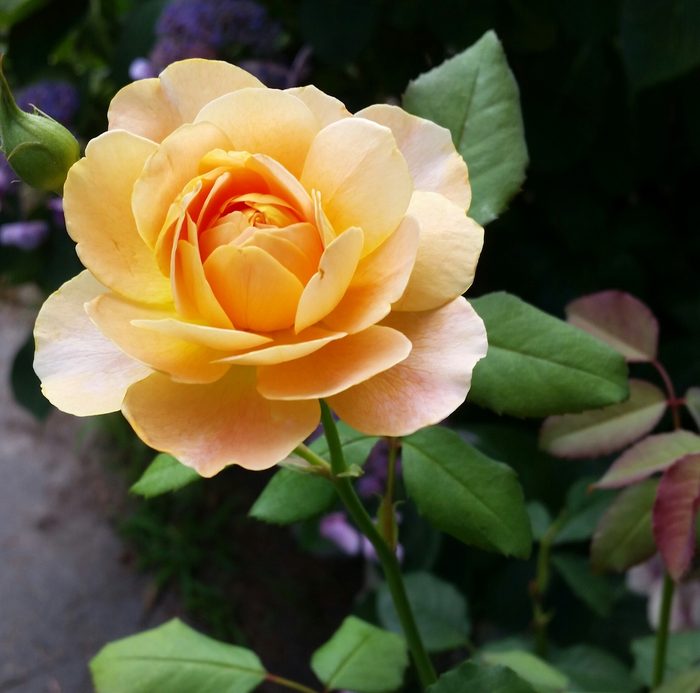
Southern gardeners probably already know this one of our facts about roses. Much like some heat-averse humans, when the temperature is over 90 degrees, roses (or rather, their foliage) will wilt. Don’t confuse this with wilting caused by underwatering…or complications of overwatering, which can make the leaves turn yellow. Psst—the gorgeous Tuscan sun rose is particularly heat tolerant.
Thinking of adding these delightful—but sometimes finicky!—plants to your garden this year? Here’s everything you need to know about growing roses.
Roses Need an Annual Pruning

Garden roses need both pruning and grooming. Pruning is done once a year and involves one severe cutback. Grooming means shaping and deadheading all season. The old-school gardening advice with roses is to prune stems at a 45-degree angle away from the bud eye. But there’s no evidence that this is necessary.
Learn the steps to grow roses from cuttings.
You Can Plant Roses in (Specific) Containers
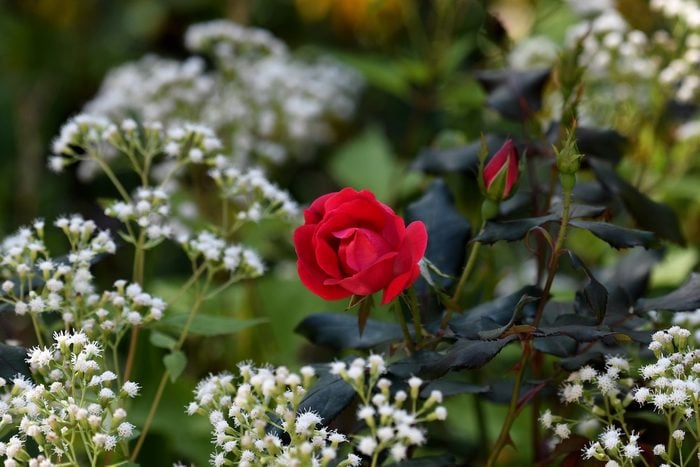
Many of today’s garden roses can be planted in containers, but they perform best in pots 18 inches in diameter with a clearance of 18 inches in height. Make sure you check the container’s dimensions before planting your roses!
Does your rose bush look unhealthy? Find out what your rose bush is trying to tell you.
Know When To Stop Growing Roses for the Season

While everyone loves bright roses during the growing season, unfortunately, they don’t keep blooming year-round in colder growing zones. It’s best to stop grooming roses six to eight weeks before your first fall frost date.
Worried about your roses surviving the cold weather? Don’t be! Use our step-by-step guide to prepare roses for winter.
There Are Hundreds of Rose Varieties
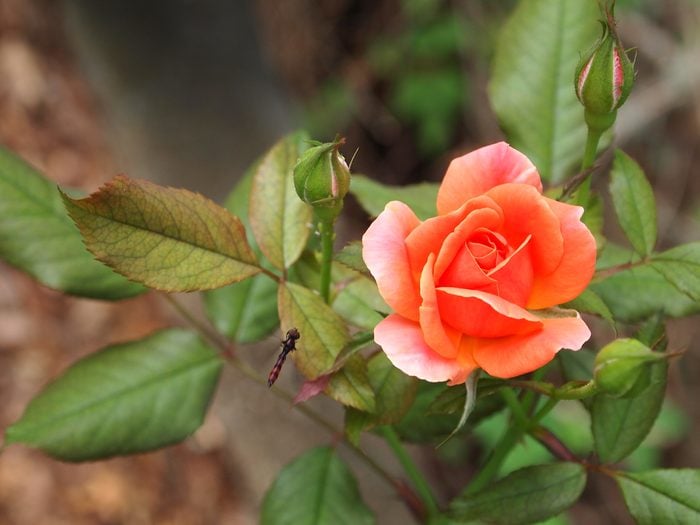
Not sure whether you want to try growing roses? There’s bound to be a species for you! There are roughly 300 varieties of roses for sale at garden centers and other stores across the U.S., and 7,000 varieties available through mail order. Knock Out Roses in particular are a favorite of many gardeners across the country.
Check out the best types of roses for every garden.
More Facts About Roses: Recognize Key Characteristics
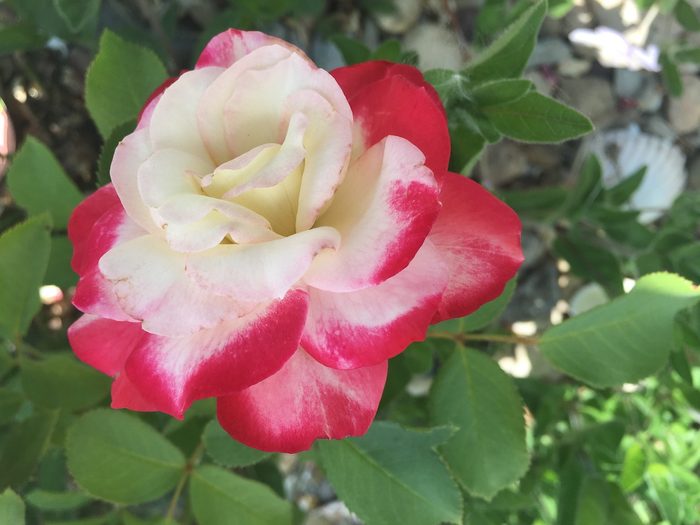
- Naturally disease-resistant
- Full foliage
- Attractive shapes—rounded, tall, or arching
- Roses have been tested, stressed, and observed by breeders for years.
After you’re done reading facts about roses, admire these pretty pictures of roses from home gardeners.
Rose Bush Care: Diagnose the Problem

It’s challenging to diagnose the visual irregularities on your roses. To figure out your rose problems and solutions, use these clues and rose bush care tips from garden pros to get started with a diagnosis.
Learn everything you need to know about growing roses.
Rose Bush Problem #1
IF YOUR ROSE: Grows rampant with few flowers
IT COULD NEED: Pruning.
For modern shrub and hybrid tea roses, simple pruning—best done before leaves emerge—promotes air circulation, bushy growth and lusty flowering. “A rose is just a blooming shrub, and you can treat it as that,” says Teresa Byington, a consulting rosarian for the American Rose Society who gardens in Indiana. For these types, the typical timing cue, she says, is when forsythia is blooming.
Remove dead, broken, crossing or diseased canes, and take down the rest by one-third of the plant’s height, she says. Single-blooming heirloom and species roses can be pruned for shape and deadheading after blooming, and climbers have their own regimen.
Roses not blooming? Find out what to do.
Rose Bush Problem #2
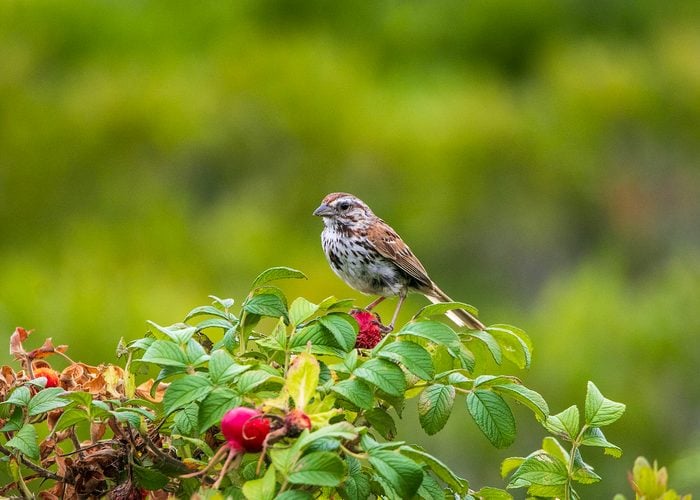
IF YOUR ROSE: Produces hard seed heads
DO THIS: Leave these rose hips for the birds or make tea.
Rose hips are the fruit that roses produce after flowering. They have up to 20 times the vitamin C of an orange and add a floral note to teas. Rose hips look stunning in fall arrangements, and birds love to snack on them. Teresa recommends deadheading flowers until about six weeks before your first frost date, and then let hips form to help the plant prepare for winter.
These are the top 10 roses for gardeners to grow.
Rose Bush Problem #3

IF YOUR ROSE: Develops black spots on the leaves
IT COULD BE: Black spot disease.
“Black spot is a fungal disease that’s spread in water when leaves are wet. It usually starts at the plant’s base and works upward,” says Stephen Scanniello, curator of the Peggy Rockefeller Rose Garden at The New York Botanical Garden and author of two rose books.
Black spot disease will defoliate—but not kill—the plant. Allowing ventilation through both pruning and plant spacing is key, as is removing the affected foliage to prevent the spread of the fungus, he says. Also, seek out resistant rose varieties—like the Knock Out rose.
Psst—roses love garlic: here’s why.
Rose Bush Problem #4

IF YOUR ROSE: Exhibits significant yellowing or dropping of leaves.
IT COULD BE: Soil issues.
“Usually underwatering and overwatering have the same symptoms,” Stephen says. “Any kind of sudden leaf drop or leaves turning yellow indicates something is wrong with the soil, such as lack of drainage or chlorosis, which is a lack of iron.” He recommends regular soil testing to learn what’s happening before addressing any issues.
Learn when to fertilize roses and peonies.
Rose Bush Problem #5
IF YOUR ROSE: Has gangly new growth and a different flower color.
IT COULD BE: Graft issues.
In this case, the rootstock variety has taken over your grafted rose and is reaching for the sky. You can buy own-root roses, which are typically hardier, but on grafted roses, bury the knobby union 2 inches below the surface, Teresa says.
Find out how to grow roses from cuttings. While you’re at it, you might like to admire the many colors of a Tuscan Sun rose, too.
Rose Problems and Solutions: Disease Cues to Look for
Pay attention to these common rose problems for hints that your plant is sick.
Downy Mildew

Red stains or bumps on the canes results from downy mildew.
Rose Rosette Disease

Broom growth or thick canes with clustered thorns indicates rose rosette disease, which is contagious. Dispose of the plants and report to roserosette.org/reporting.
Powdery Mildew

Fuzzy white patches or spots on the leaves indicates powdery mildew.
Next, discover the best types of roses for every garden.
Overgrown Rose Bush Care

This is a story about an old, overgrown rose bush. This poor rose hadn’t been cared for or pruned for a few years. To be honest, I think it looks great considering the lack of care it had received. But if you looked further inside, you would see lots of dead wood.
This rose bush was located on a small farm that my mother, sister and her family had recently moved to.
I absolutely love roses and couldn’t wait to help this plant. When I started, I had no idea what variety this rose was. However, I was pretty sure that it was a shrub rose, and it had a lot of old, unproductive growth that needed to be removed.
Here’s how I got started.
Check out the top 10 best roses for gardeners to grow.
Pruning the Overgrown Rose
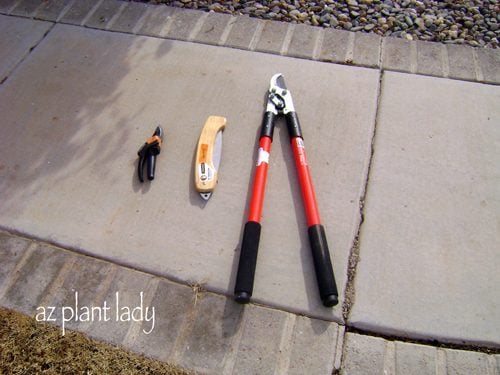
First things first: I highly recommend wearing gardening gloves and long sleeves so you don’t get hurt by the thorns.
Because there was so much thick growth, I just started pruning in order to make a hole so that I could reach inside and prune the old wood. When pruning, it is saves you a lot of work if you first cut toward the base of larger branches. This prevents you from making multiple pruning cuts of smaller branches.
When pruning roses, I normally remove half to two-thirds of the growth. For this rose bush, I decided to remove quite a few of the large old branches (called canes) at the base of the rose because they no longer produced as many newer branches and flowers as the younger branches did.
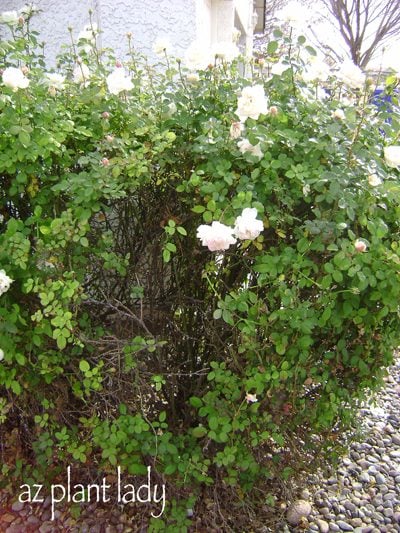
I removed the old and dead canes and then selected the green, healthy canes that I would keep. Then I pruned the healthy canes back to an outward facing bud and cut them at a 45 degree angle.
I used my hand pruners for the small canes and then switched to my loppers for the larger canes. Soon I had a large pile of clippings. Thankfully I had some great helpers (my kids).
Learn when to fertilize roses and peonies.
How to Remove Rose Cane Borers
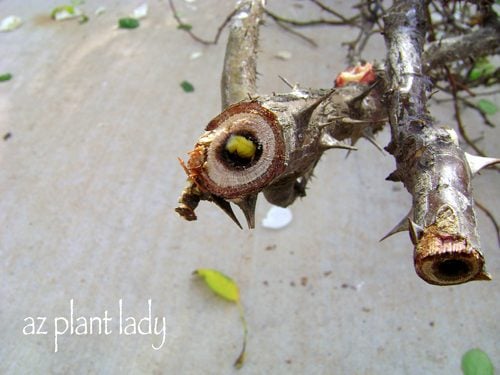
While cutting back some of the old canes, I discovered a cane borer that had burrowed its way down into this rose cane. Cane borers enter through the top of rose canes and burrow their way down, causing death and damage.
To remove cane borers, simply prune the cane until there is no longer a hole down through the center. To prevent borers, simply apply white glue to the tops of pruned canes, which will keep them out.
Here’s how to grow roses from cuttings.
Two Overgrown Rose Bushes
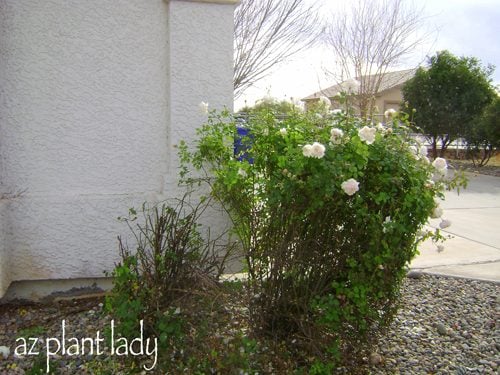
As I continued pruning back the rose bush, I came upon an unexpected discovery. There were actually two rose bushes that had grown together! I also found examples examples of bad pruning like this one (below). You can see where the cane turned brown and died.
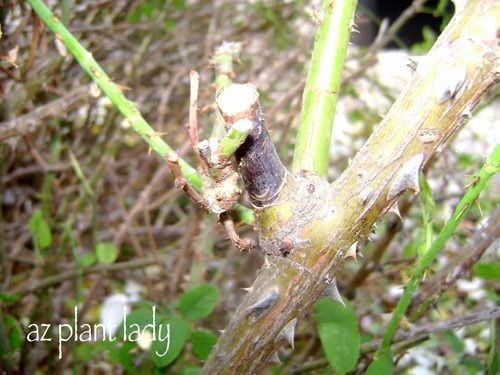
When pruning rose canes, trim back to a bud or back to the base of a larger cane.
Find out why Knock Out Roses are a gardener’s dream come true.
Cleanup and Disease Prevention
The final step was to remove all the remaining leaves and clean up any surrounding fallen rose leaves. I did this because the leaves can harbor fungal diseases that will reinfect new rose leaves.
Roses not blooming? Here’s what to do.
Identifying the Nameless Rose
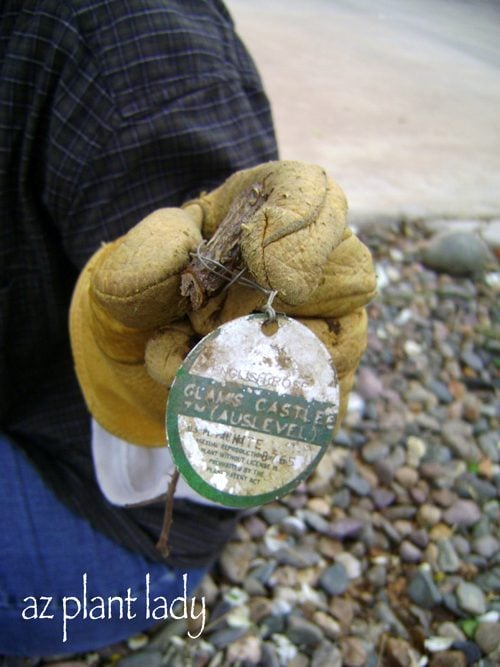
As I was finishing up, I discovered a surprise buried in the soil. I found the original label for the rose bushes. They are the variety ‘Glamis Castle’, which is an ever-blooming shrub rose. These roses were no longer neglected or nameless.
Psst—have you ever seen Green Roses?
After Pruning: The Finished Result
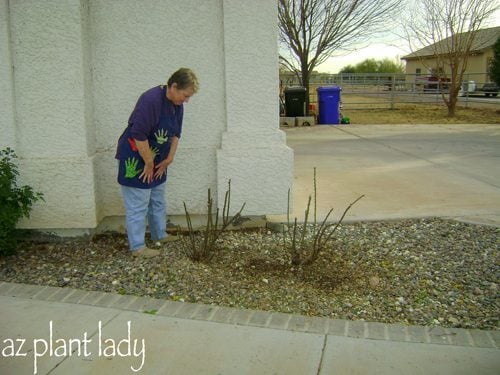
After I finished pruning, the rose bushes hardly resembled their former selves. I think my mother was a bit surprised at the how different they looked. A few months later, they were full of healthy foliage and beautiful blooms.
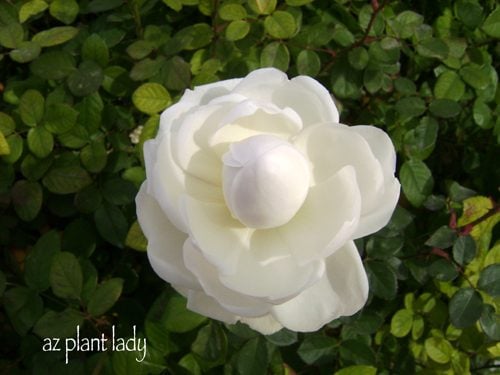
Although the pruning was drastic, it needs to be done with most of today’s modern rose types including grandiflora, hybrid tea and floribunda. As they say, “beauty hurts” and proper pruning ensures that there will be more beautiful blooms in spring.
When to prune your roses depends on which USDA zone you live in:
- Zones 6 to 8 prune back in February.
- Zones 9 to 10 prune back in January.
- All other zones, prune back in early spring, before new leaves grow
Don’t miss pretty pictures of roses from home gardeners.
Ask the Experts: When to Fertilize Your Roses

I have six David Austin English roses in my yard. A couple of them have blooms that droop over and hang almost upside down. What causes this?” asks Birds & Blooms reader Gayle Romines of Greenbackville, Virginia.
Horticultural expert Melinda Myers: Large rose blossoms, common on many David Austin roses, often nod or droop. This does vary with varieties. As the plant matures and stems become thicker, the plant provides better support for the blossoms and the drooping is less noticeable.
Prune the plants by no more than half in the winter, and fertilize roses twice a year with a low-nitrogen, organically based fertilizer. These steps will promote sturdy growth without interfering with flowering.
Did You Know: David Austin roses are known for being beautiful, yet easy to maintain.
Check out the best types of roses for every garden.
Fertilize and Revive Peonies

“Is there any way to revive my 50-year-old peony plant?” asks Hazel Maki of Menominee, Michigan.
Melinda Myers: Peonies can survive many decades when grown in sunny spots with well-draining soils. Increasing shade or competition from tree roots may be causing your plant to decline. If this is the case, move it to a sunnier location this fall.
Prepare the soil before planting, as your peony may stay in place for 50 years or more. Make sure the eyes, the growing points at the base of the stems, are no more than an inch below the soil surface. If the plant is receiving sufficient sunlight (six or more hours), it may need a nutrient boost. Consider adding a low-nitrogen, slow-release fertilizer to the soil in spring. This will encourage slow, steady growth, but will not interfere with flowering.
How to Problem Solve: If a plant you’ve had for years is suddenly not growing well, check if its growing conditions have changed. A mature tree may be casting more shade, or an especially rainy season can affect how well established plants grow and bloom.
Next, learn how to grow peonies in pots and containers.
Tuscan Sun Rose Benefits
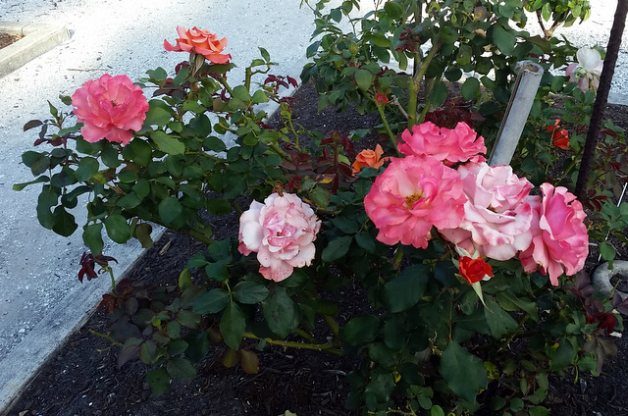
Florida summers are terribly hard on roses, which need a lot of TLC even in ideal climates. For me to actually plant a rose, it has to be easy to care for and spectacular to boot. To earn a place in my garden, a rose must be disease-resistant, able to handle heavy rains and high humidity all summer long, and provide lots and lots of beautiful blooms. As you can imagine, there aren’t too many roses that meet my needs, so I was excited to come across the Tuscan Sun rose during a recent visit to a rose garden in Sarasota, Florida.
In addition to its toughness, the blooms have a mild spicy fragrance and make excellent cut flowers.
What Does a Tuscan Sun Rose Look Like?
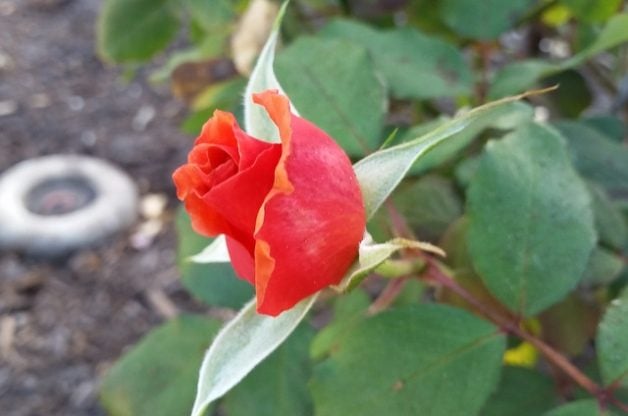
The Tuscan Sun rose caught my eye initially with an array of different colors of blooms on a single bush. The buds start out a brilliant orange, opening to display a deep apricot-colored flower. As the flower begins to age, its outer petals take on a pinkish hue, making the blooms bi-colored. Eventually, the whole flower becomes bright pink, fading gently to pale pink over time.
Psst—this easy-care coral shrub rose is ravishing.

Because the rose is a floribunda, the blooms appear in a multitude of clusters and all these colors can be seen at once on the same bush. The effect is pretty spectacular, and rather like having three or four roses all in one.
Check out the top 10 best roses for gardeners to grow.
Tuscan Sun Rose Care
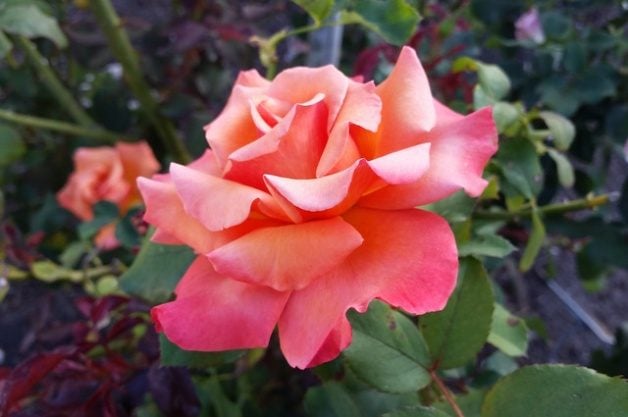
Tuscan Sun roses grow in zones 6 to 10, and may survive winters in zone 5 with extra mulching and protection. They’re noted for disease-resistance, being able to fight off both powdery mildew and rust. This means a Tuscan Sun rose actually has a decent chance of flourishing in the strong summer rains and sky-high humidity of a southern summer. It’s a bush rose, growing to 4 feet high and 3 feet wide.
Learn when to fertilize roses and peonies.
Where to Buy
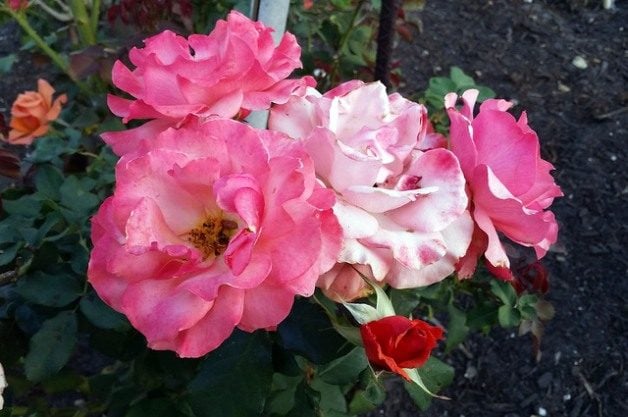
You can find Tuscan Sun roses at multiple online vendors, including Jackson & Perkins, or ask your local garden center or nursery to help you locate one.
Next, get tips for planting bare root roses.
Grow Green Roses for Stunning Color
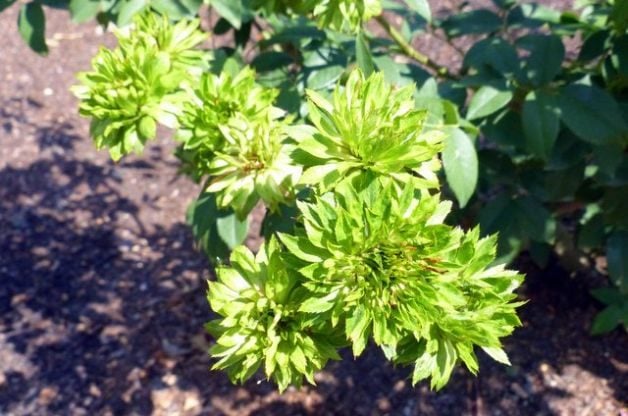
True rose gardeners can be a bit…obsessive. You know it’s true. Roses are notoriously tricky to grow for many people, and those who do it best really get to know their plants. They feed them, water them, prune and deadhead like a celebrity stylist, and even talk to them when the neighbors aren’t looking. Their roses reward them with an array of blooms in just about every color, and the rose gardeners delight in adding new beauties to their collection. So whether you are a rose gardener or you know someone who is, you’ll be fascinated to find out that Green Roses do exist.
Less experienced in growing roses? Here’s how to get started.
What You Should Know About Green Roses
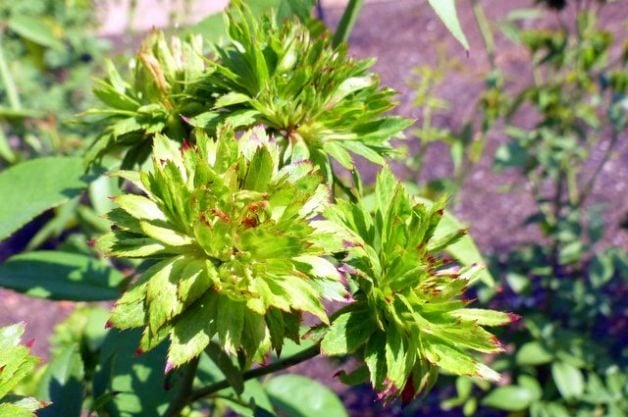
My mother and I found this unique rose growing at the Leu Botanical Gardens in Orlando. My mom is a true rose gardener, and so even though the sweat was pouring down our backs in the hot Florida spring sun, we happily wandered through the largest collection of roses on the Eastern seaboard, admiring the thriving flowers. Just when we thought we’d seen it all, we came upon something we’d never seen before.
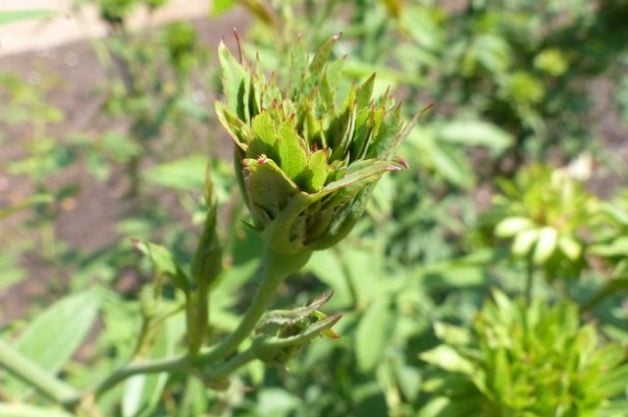
The Green Rose, Rosa chinensis ‘Viridiflora’, is a very old rose. The sign indicating that it has green “petals” isn’t quite correct, though. The fascinating thing about the Green Rose is that it has no petals at all. Instead, the blooms produce only a multitude of sepals, which usually serve as protection for flowers in bud and as support for petals once they open.
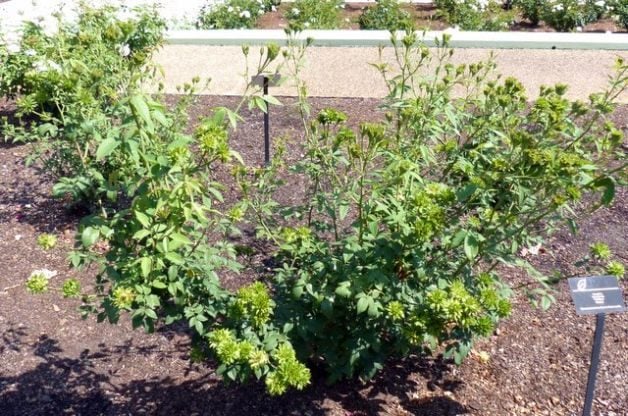
Lacking petals and other traditional flower parts, the Green Rose has no traditional rose fragrance. Instead, a deep sniff reveals a sort of peppery scent. It “flowers” in abundance, with dozens of sepal blooms covering the shrubby plant.
You can grow it in zones 5 to 10, but provide extra mulch for winter protection in zones 5 and 6. It also is reported to grow well in pots. If you grow a Green Rose in a container, you can overwinter it inside for the colder months as needed.
These are the top 10 roses to grow in your garden.
Green Rose History
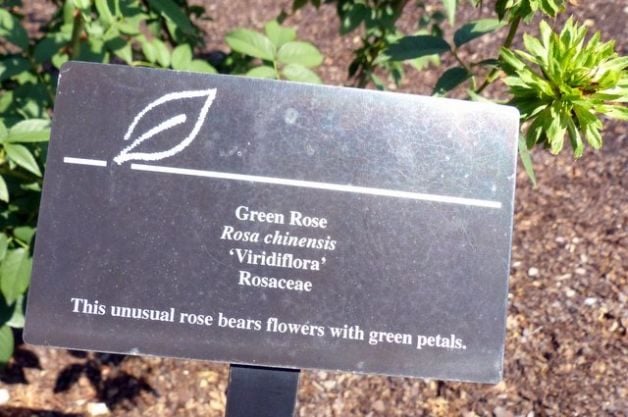
The Green Rose is a natural mutation. Like many mutants, it produces no viable flowers and thus has no hips to produce seed. That sterility means that all Green Roses grow from taking another plant’s cuttings. (Psst—here’s how to grow roses from cuttings).
Since it’s unknown how often this mutation occurs in nature, it’s possible that all Green Roses today stem from one specimen grown in an ancient garden. Most rose historians agree this rose originated in China, where some say it was grown only for royalty to enjoy in the Forbidden City. Documented as early as 1743, the rose registry dates it to 1856.
Roses not blooming? Here’s what to do.
Where to Buy Green Roses
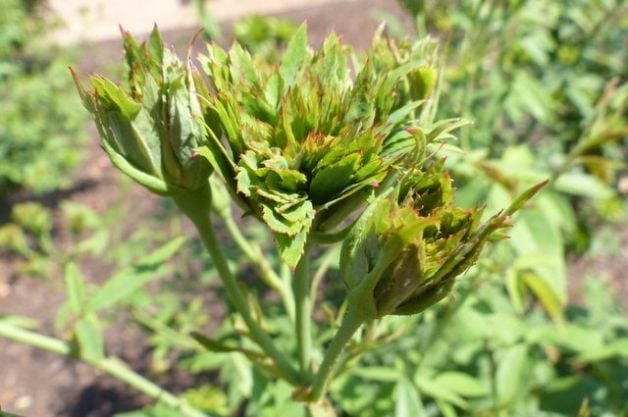
You’ll find Green Roses for sale from a variety of places online, including The Antique Rose Emporium. Or contact your local nursery or garden center to see if they can locate a plant for you.
Next, check out these fragrant roses that are sure to sweeten up your garden.